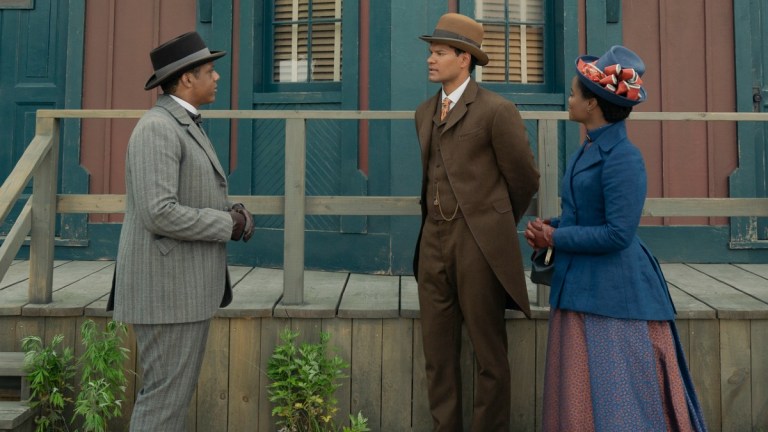How The Gilded Age Season 2 Recreated The Tuskegee Institute
The Gilded Age season 2 depicts Booker T. Washington, the Tuskegee Institute, and the beginning of HBCUs.

This article contains spoilers for The Gilded Age season 2 episode 5.
The Gilded Age has woven the story of Black New Yorkers into the larger fabric of its depiction of 1880’s society. Season 2 expands on this foundation by also showing a slice of what life was like in the South during the same period.
Peggy (Denée Benton) is very eager to cover the most important stories of the day for T. Thomas Fortune’s (Sullivan Jones) newspaper. Covering the Red Cross’s relief work last season has also whet her appetite for traveling beyond the city. During season 2 the opportunity to cover a big and meaningful story presents itself when Booker T. Washington offers Peggy and Fortune the opportunity to cover the opening of a new dormitory at the Tuskegee Institute in Alabama.
The Tuskegee Institute, now called Tuskegee University, was founded in 1881 just two years before the main plot of the series begins. Tuskegee was one of the first Historically Black Colleges and Universities in the US (frequently shortened to HBCU) to offer Black students degrees and job training. In the 1880’s, most predominantly white private and public colleges refused to accept Black students regardless of their academic achievements or career interests.
While Peggy’s main concern on her trip is the social optics of a single woman traveling alone with a married man, Dorothy’s concerns for her daughter in episode 3 “Head to Head” go far deeper. Peggy grew up in the North and never experienced the Jim Crow South. While New York was socially segregated, the law in Alabama and the other Southern states in the 1880’s rigorously enforced segregation in all areas of life. There are rules for survival Peggy has no idea about and she dismisses her mother’s warnings as being too strict.
During episodes 4 and 5, Peggy and Fortune get a tour of the Tuskegee Institute facilities and also get the opportunity to speak to students about their studies and how they feel about the future. Unfortunately, in episode 5, Peggy and Fortune also get a taste of the aggressive and violent racism that Washington and his students face every day in Alabama.
Den of Geek interviewed writer and executive producer Sonja Warfield, production designer Bob Shaw, and costume designer Kasia Walicka Maimone to find out more about Peggy’s characterization this season and how they brought the world of the Tuskegee Institute to life.
Many The Gilded Age fans may not realize this but both Warfield and the series historical advisor Dr. Erica Dunbar are Black and their ideas and perspectives have played a huge role in shaping Peggy’s overall plot. During a brainstorming session for season 2, Dunbar told Warfield about how the series timeline coincides with Washington starting the institute.
“After this discussion she did more research and she found out that there was a man in New York who donated a lot of money to Tuskegee that helped them build the dormitory. We immediately knew we had a gem and we just went with it,” Warfield says.
Once the connection to New York was made, the next step was to shift Peggy’s character from the end of season 1 into season 2 in a direction where she could cover the Tuskegee Institute’s opening.
“She couldn’t move forward and she couldn’t do all of the things that we have set out for her to do if she had a child,” Warfield says. “This is a character who is forging her own path and breaking new ground. Despite her grief, she’s moving on.”
Show creator Julian Fellowes has always strived for The Gilded Age to portray what America looked like in the 1880s and the Tuskegee plot was no exception.
“There was the North where Black people had some freedoms, and then there was the South, which worked in a way opposed to everything Peggy ever knew,” Warfield says. “We wanted to put her there to see the difference.”
The original location of the Tuskegee Institute is now maintained by the National Parks Service. The Gilded Age did not film these scenes on location as the site is closed to visitors until March 2025 for repairs. In fact all of the Tuskegee scenes were filmed at Old Bethpage Village on Long Island, New York. Bethpage in fact consists of several historical buildings from the 1600s through 1870s that were moved from other parts of the island in order to preserve them.
“We were fortunate that Old Bethpage Village is literally right on the other side of the road from our backlot set where we have our 1880s’ street,” Shaw says.
Shaws’ work in transforming the Bethpage buildings into the Tuskegee Institute was informed by conveying Peggy’s state of mind visually.
“Peggy didn’t even understand what role the South played in her own backstory,” Shaw says. “People still experience that to this day of not knowing what the rest of the country is like for all different kinds of people on all different kinds of levels.”
The costume design also plays a role in showing the contrasts between the Tuskegee Institute and 61st Street on screen.
“We knew that the costumes needed to be in lighter colors and in lighter weight fabrics such as linen,” Walicka Maimone says. “The goal was for the costumes to display a different visual country.”
The costume design process for scenes starts between six weeks and two months before shooting. Walicka Maimone maintains a library of over 36,000 images from the 1880’s that are used as references for both principal actor and background extra costume design.
Viewers who know the history of the South during the 1880’s knew that at some point Dorothy’s warning was going to come to pass. During episode 5, while Peggy and Fortune are having dinner in a restaurant, Fortune overhears a racist white man insulting one of the Tuskegee students. Fortune decides to intervene and is later chased by a lynch mob. “She’s got to go anyway, to save herself,” Warfield says. “This is something that she has to do.”
The Gilded Age airs on HBO and streams on Max at 9 p.m. ET on Sunday nights.
